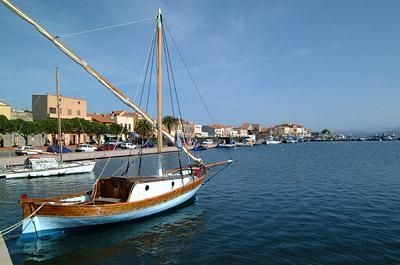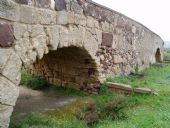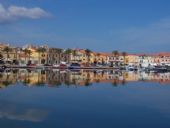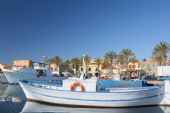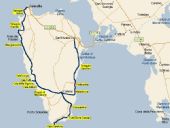
Sant'Antioco Island
southwest of Sardinia
Located in the southwest of Sardinia, which is united by an artificial isthmus of about 3 km., The island is part of Sant'Antioco Sulcis Archipelago. With an area of about 109 sq km., Sant'Antioco is scope for the fourth island in Italy, presenting an area of Oligo-Miocene aged volcanic, except for a small patch of limestone formation located on the east coast.
To the south, the coast alternates rocky expanses of sand, while over Maladroxia beach, cliffs that stand guard coves and inlets of extraordinary beauty lapped by crystal clear water and of intense turquoise.
The two main towns on the island are Sant'Antioco and Calasetta, while other smaller settlements have mostly character flashing, as Maladroxia and Cussorgia.
Sant'Antioco, sort of a Nuraghic settlement and later on the ruins of the Phoenician Sulcis (VIII century BC.), Lies in the eastern part of the island, from the slopes of the castle hill descending to the sea.
The country has the typical appearance of the villages of fishermen, with low houses and colorful, and narrow streets paved in stone.
In the upper part there is the parish church of Sant'Antioco built in sec. XII of early Christian site with late Baroque façade. Overlooking the Gulf of Palmas, dominated by the beautiful Torre Cannai (XVII sec.), Sant'Antioco was one of the most important ports of the Mediterranean from where departed ships loaded with precious extracts from the mines in the region.
The small home port for ferries is located near the town and the Port Roman Bridge which represents the old commercial port. The marina is located at the waterfront De Pompeis instead.
A few minutes away is Calasetta, second municipality. Its port, where we embarked for Carloforte, you can reach to the west, three beautiful beaches, which are the Sottotorre Beach, the beach of Saline and Spiaggia Grande.
On the extreme southern tip of the island and within easy reach, is Capo Sperone, which has beautiful views of the rocks overlooking the sea.
To visit the archaeological museum with exhibitions and the Museum of Ethnography.
To the south, the coast alternates rocky expanses of sand, while over Maladroxia beach, cliffs that stand guard coves and inlets of extraordinary beauty lapped by crystal clear water and of intense turquoise.
The two main towns on the island are Sant'Antioco and Calasetta, while other smaller settlements have mostly character flashing, as Maladroxia and Cussorgia.
Sant'Antioco, sort of a Nuraghic settlement and later on the ruins of the Phoenician Sulcis (VIII century BC.), Lies in the eastern part of the island, from the slopes of the castle hill descending to the sea.
The country has the typical appearance of the villages of fishermen, with low houses and colorful, and narrow streets paved in stone.
In the upper part there is the parish church of Sant'Antioco built in sec. XII of early Christian site with late Baroque façade. Overlooking the Gulf of Palmas, dominated by the beautiful Torre Cannai (XVII sec.), Sant'Antioco was one of the most important ports of the Mediterranean from where departed ships loaded with precious extracts from the mines in the region.
The small home port for ferries is located near the town and the Port Roman Bridge which represents the old commercial port. The marina is located at the waterfront De Pompeis instead.
A few minutes away is Calasetta, second municipality. Its port, where we embarked for Carloforte, you can reach to the west, three beautiful beaches, which are the Sottotorre Beach, the beach of Saline and Spiaggia Grande.
On the extreme southern tip of the island and within easy reach, is Capo Sperone, which has beautiful views of the rocks overlooking the sea.
To visit the archaeological museum with exhibitions and the Museum of Ethnography.
-
Search
-
Categories
- APP FAITA Sardegna
- HOLIDAY PACKAGES
- CAMPING VILLAGE Sardinia
- Where to eat
- TRANSPORT Sardinia
- BEACHES in Sardinia
- Tours in Sardinia
- KITCHEN traditional Sardinian
- WINES Sardinia
- SPIRITS of Sardinia
- EVENTS in Sardinia
- CORTES Apertas in Sardinia
- SPORT in Sardinia
- MAP Sardinia
- PHOTOS Sardinia
- VIDEO Sardinia
- Useful Numbers Sardinia
- DOGGIE BEACH in Sardinia
- Contact information
- archivio
-
Topics
- Camping e Village Sardinia
- Tourism in Sardinia
- resorts in Sardinia
- Sardinian beaches routes
- Specialties at the table
- South Coast Cagliari
- Costa Rei itinerari
- Ogliastra itinerari
- Nuoro e provincia itinerari
- Gallura itinerari
- Sassari e provincia itinerari
- Oristano e provincia itinerari
- Autunno in Barbagia 2013
- Aerei per la Sardegna
- Traghetti per la Sardegna
- Storia di Sardegna
- Feste e sagre della Sardegna
- Camping Village e Spiagge dog friendly
- Spiagge accessibili con l'amico cane






